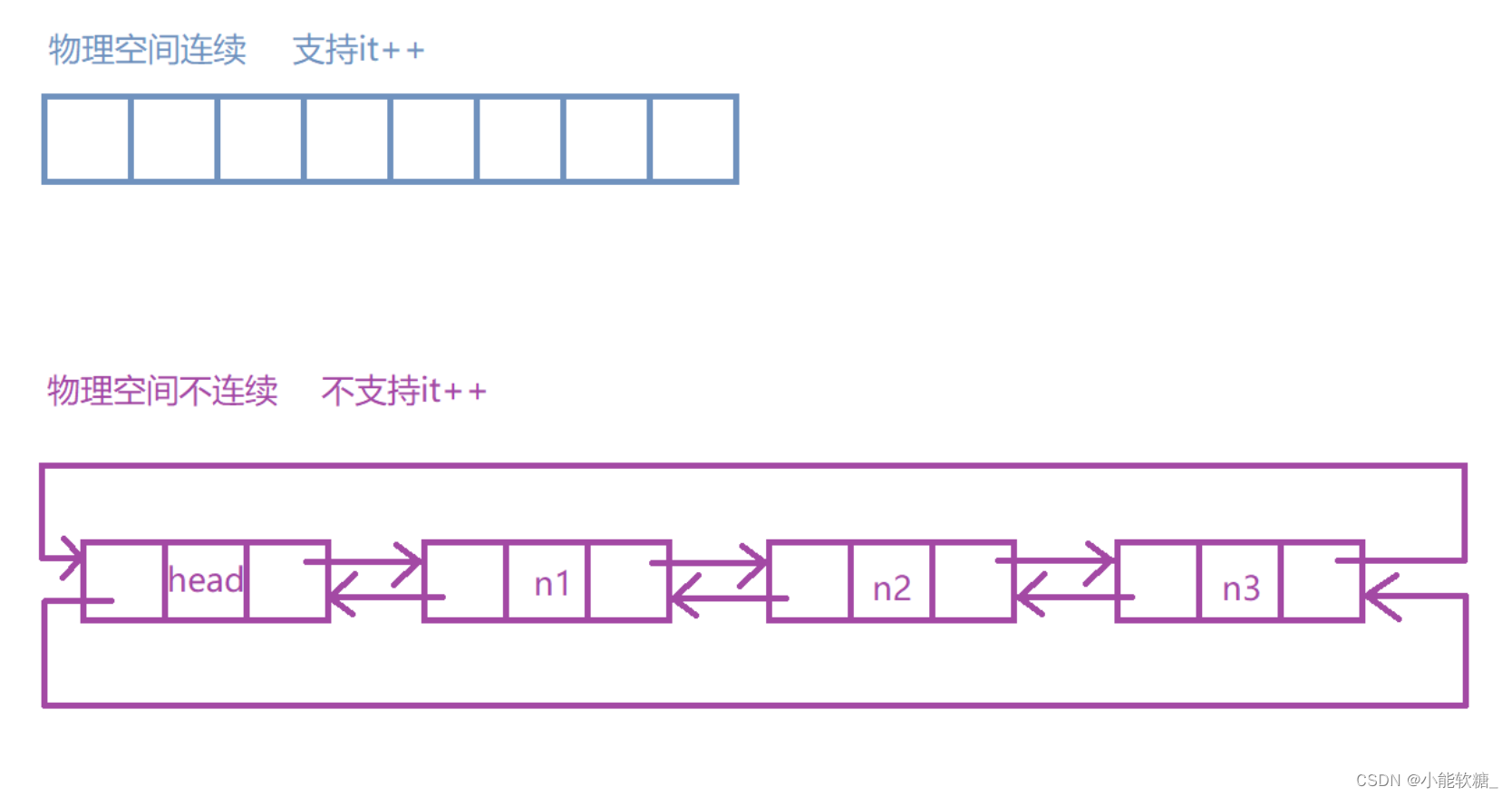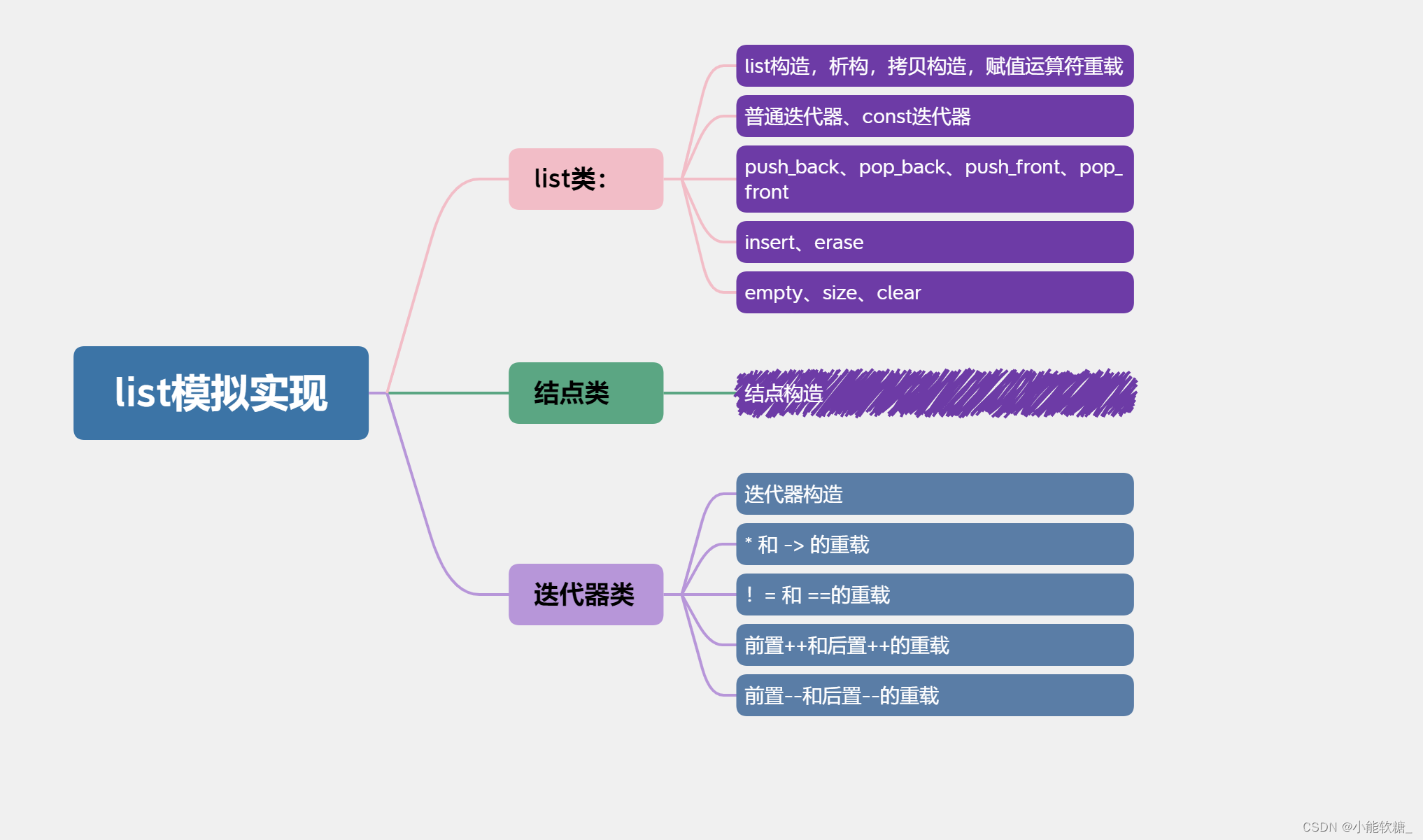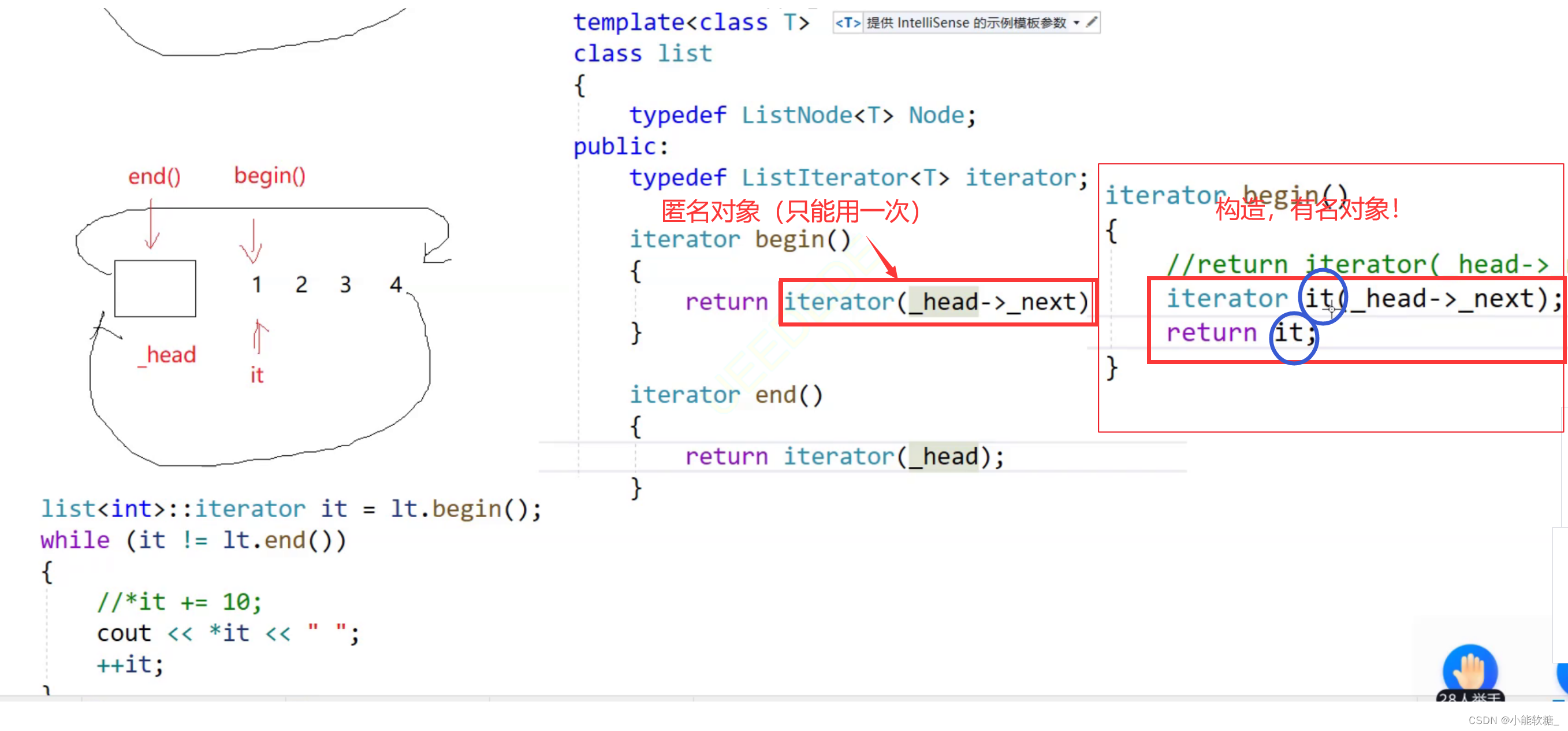【C++】---STL之list的模拟实现
一、list模拟实现思路二、结点类的实现三、list迭代器的实现1、ListIterator类2、构造函数3、operator*运算符重载5、operator->运算符重载6、operator!=运算符重载7、operator==运算符重载8、前置++9、后置++10、前置--11、后置-- 四、list类的实现1、list类2、构造3、析构4、拷贝构造5、赋值运算符重载(1)传统的赋值运算符重载(2)现代的赋值运算符重载 6、迭代器7、insert()8、erase()9、clear()10、push_front()11、push_back()12、pop_front()13、pop_back()14、empty()15、size() 五、完整代码
一、list模拟实现思路
list的模拟实现比 string vector的模拟实现略微复杂一点:
(1)由于链表的每一个结点本身就是一个结构体,里面包括数据和指针,所以在接下来的模拟中,我们会将链表的每一个结点封装为一个类,也就是结点类。
(2)链表中数据的物理储存空间是不连续的,但是string和vector他们的数据储存物理空间是连续的。因此在访问链表的数据的时候,不能用原生的迭代器来进行访问,我们需要自己重载一个迭代器,自己封装一个迭代器的类。

list的模拟的大体思路:

二、结点类的实现
单个结点类的成员变量有三个:
(1)结点值:_val
(2)指向前一个结点的指针:_prev
(3)指向后一个结点的指针:_next
结点无需拷贝构造、赋值运算符重载,由于没有额外申请空间,因此也不需要析构
// 1.单个的结点类:template<class T>struct Listnode{T _val;Listnode<T>* _next;Listnode<T>* _prev;// 构造:Listnode(const T& x = T()):_val(x), _next(nullptr), _prev(nullptr){}};三、list迭代器的实现
1、ListIterator类
(1)我们为什么要对链表的迭代器进行一个单独的封装?
因为之前普通的迭代器++都是连续,可以直接进行访问数据。
但是链表不一样,物理空间连续所以说我要把这个迭代器进行一个类的封装,然后在里面对他运算符重载(例如:++)我们就可以掌控这个迭代器的行为!
当原生的迭代器或者运算符不合我们所需要的预期的话,就可以把它进行一个封装,我们自己来重载,达到我们所需要的预期
(2)迭代器有两种,一种是普通迭代器,一种是const的迭代器
为了不使代码冗余,我们就会将两个迭代器写在一起,用模板!
对于T&,类模板实例化出两个类,一个是T&类,一个是const T&类,同理,T*也一样。使用 :
template<class T,class Ref,class Ptr>// Ref==T& Ptr==T*类模板就会实例化出来两个类,一个是普通的、不带const的T,T&, T*,另一个是带const的T,const T&, const T*,其中Ref是引用,Ptr是指针,该类模板实例化了以下这两个类模板:
template class<T,T&,T*> iterator;template class<const T, const T& ,const T*> const_iterator;这样我们就解决了两个类的问题。
2、构造函数
template<class T,class Ref,class Ptr>struct ListIterator{typedef Listnode<T> Node;// 1.(这个是单个结点“类型”的重定义) 不管你是什么类型的结点 我都给你整成Node,因为Listnode<T>是一个结点模版!typedef ListIterator<T, Ref, Ptr> Self; // 2.(这个是本迭代器指针“类型”的重定义)// 成员变量:Node* _node;// 构造:ListIterator(const Node* node):_node(node){}};3、operator*运算符重载
// 重载*(*it)// Ref==T&Ref operator*()// 为什么要传引用返回呢?因为有的时候我们可能需要对it进行修改+1,-1等等。{return _node->_data;}5、operator->运算符重载
// 重载->//Ptr==T*Ptr operator->(){6、operator!=运算符重载
对于==和!=的重载的时候,我们一定要想清楚到底是对它里面节点的值来判断相不相等,还是说来判断指向这个结点的迭代器指针相不相等。很明显我们这里重载( = =)和(!=)通过判断结点的迭代器相等不相等来进行重载的。
// !=bool operator!=(const Self& it){return _node != it._node;}7、operator==运算符重载
比较两个迭代器相等不相等的时候一定不能比较所指向节点中的值,万一所有的节点里面值相等都是一样,那你意思就是说:这里面的所有迭代器都是相等吗?不就扯淡吗?!所以说比较迭代器相不相等:就是比较两者是不是指向同一个结点(即:比较指针是否相等!)因为迭代器本质上是指针!
bool operator==(const Self& it){return _node == it._node;}8、前置++
//前置++,(++it)Self& operator++()//因为++对内容进行了修改,所以要传引用返回!{_node = _node->_next;return *this;}9、后置++
//后置++,(it++)Self operator++(int){Self tmp = *this;//因为后置++,要返回的是++之前的值,所以要先保存未++的值在tmp里面!_node = _node->_next;return tmp;}10、前置–
//前置--,(--it)Self& operator--()//因为--对内容进行了修改,所以要传引用返回!{_node = _node->_prev;return *this;}11、后置–
//后置--,(it)Self operator--(int){Self tmp = *this;//因为后置--,要返回的是--之前的值,所以要先保存未--的值在tmp里面!_node = _node->_prev;return tmp;}四、list类的实现
1、list类
list的成员只需要一个头节点,然后通过迭代器来访问后面的其他元素即可。
2、构造
//1、构造:list(){_head = new Node;//会调ListNode的构造函数_head->_next = _head;//整个链表只有头节点,先构造一个没有实际节点的链表_head->_prev = _head;//整个链表只有头节点,先构造一个没有实际节点的链表}3、析构
// 2、析构~list(){clear();delete[] _head;_head = nullptr;}4、拷贝构造
//特意写一个,初始化一个哨兵位void empty_init(){_head = new Node;_head->_next = _head;_head->_prev = _head;_size = 0;}// 3、拷贝构造// lt2(lt1)list(const list<T> lt){empty_init();//先初始化一个头结点for (auto& e : lt)// 接下来在哨兵位后面 尾插 就可以实现拷贝构造!{push_back(e);}}// 需要析构,一般就需要自己写深拷贝// 不需要析构,一般就不需要自己写深拷贝,默认浅拷贝就可以};5、赋值运算符重载
(1)传统的赋值运算符重载
//赋值运算符重载 lt1 = lt 传统写法list<T> operator=(const list<T>& lt){ //链表已存在,只需将节点尾插进去即可if(this != lt){for (auto& e : lt){push_back(e);}}}(2)现代的赋值运算符重载
//4、赋值运算符重载(深拷贝)// lt1=lt2list<T>& operator=(list<T> lt){swap(lt);return *this;}void swap(list<T>& lt){std::(_head, lt._head);std::(_size, lt._size);}6、迭代器
(1)普通迭代器:
iterator begin(){//iterator it = _head->_next;// 有名对象 //调用迭代器的构造函数创建一个迭代器it//return it;return iterator(_head->_next);// 匿名对象// return _head->_next; // 不能这样写,因为返回类型是迭代其指针,而你这样返回的是一个结点。}iterator end(){return iterator(_head);}只要你有节点的指针,就可以构造迭代器:
下面这里就是构造了一个迭代器,因为它的返回类型是迭代器,你只要有节点的指针我就可以构造一个迭代器,只不过有两种情况是匿名对象,另外一种是有名对象:

(2)const迭代器:
const_iterator begin() const{return const_iterator(_head->_next);//头节点不存数据} const_iterator end() const{return const_iterator(_head);//尾节点的下一个节点位置即头节点}7、insert()
// 3.insertvoid insert(iterator pos, const T& val)//在pos位置之前插入val{//先用一个指针保存pos的位置!Node* cur = pos._node;//创建一个新的节点newnode来接受val的值Node* newnode = new Node(val);//再保存pos位置前一个方便newnode插入!Node* prev = cur->_prev;//prev newnode cur三者之间的交换newnode->_prev = prev;prev->_next = newnode;newnode->_next = cur;cur->_prev = newnode;}8、erase()
iterator erase(iterator pos){// 1、先保存pos位置的前后!Node* cur = pos._node;Node* prev = cur->_prev;Node* next = cur->_next;// 2、prev 和 next两者之间进行链接!prev->_next = next;next->_prev = prev;// 3、直接删除curdelete cur;// 4、因为是模拟原本库里面的erase函数,返回的就是要删除pos位置的下一个位置的迭代器。return iterator(next);}9、clear()
void clear(){iterator it = begin();while (it != end()){it = erase(it);//因为erase会返回要删除结点的下一个位置,所以要用iterator类型的it接受!}}10、push_front()
// 头插void push_front(const T& x){insert(begin(), x);}11、push_back()
// 尾插void push_back(const T& x){insert(end(), x);}12、pop_front()
// 头删void pop_front(){erase(begin());}13、pop_back()
// 尾删void pop_back(){erase(--end());}14、empty()
bool empty(){return (_head->_next == _head);}15、size()
size_t size()const{size_t count = 0;Node* cur = _head;while (cur->_next != _head){cur = cur->_next;count++;}return count;}五、完整代码
#pragma once#include <assert.h>#include<iostream>using namespace std;namespace yjl{template<class T>struct Listnode{Listnode<T>* _prev;Listnode<T>* _next;T _data;//单个节点之间的内部构造Listnode(const T& x = T()):_prev(nullptr), _next(nullptr), _data(x){}};/// ///list迭代器的封装://template<class T>//struct ListIterator//{//typedef Listnode<T> Node;// 1.(这个是单个结点“类型”的重定义) 不管你是什么类型的结点 我都给你整成Node,因为Listnode<T>是一个结点模版!//typedef ListIterator<T> Self; // 2.(这个是本迭代器指针“类型”的重定义)//Node* _node;////构造//ListIterator(Node* node)//:_node(node)//{}//// 重载*(*it)//const T& operator*()// 为什么要传引用返回呢?因为有的时候我们可能需要对it进行修改+1,-1等等。//{//return _node->_data;//}//// 重载->//const T* operator->()//{//return &_node->_data;//得到的是地址:T*//}////前置++,(++it)//Self& operator++()//因为++对内容进行了修改,所以要传引用返回!//{//_node = _node->_next;//return *this;//}////后置++,(it++)//Self operator++(int)//{//Self tmp = *this;//因为后置++,要返回的是++之前的值,所以要先保存未++的值在tmp里面!//_node = _node->_next;//return tmp;//}////前置--,(--it)//Self& operator--()//因为--对内容进行了修改,所以要传引用返回!//{//_node = _node->_prev;//return *this;//}////后置--,(it)//Self operator--(int)//{//Self tmp = *this;//因为后置--,要返回的是--之前的值,所以要先保存未--的值在tmp里面!//_node = _node->_prev;//return tmp;//}//bool operator!=(const Self& it)//{//return _node != it._node;//}//bool operator==(const Self& it)//{//return _node == it._node;//}//};// typedef ListIterator<T,T&,T*> iterator;// typedef ListIterator<T,const T&,const T*> const_iterator;//list迭代器的封装:template<class T,class Ref,class Ptr>// Ref==T& Ptr==T*struct ListIterator{typedef Listnode<T> Node;// 1.(这个是单个结点“类型”的重定义) 不管你是什么类型的结点 我都给你整成Node,因为Listnode<T>是一个结点模版!typedef ListIterator<T,Ref,Ptr> Self; // 2.(这个是本迭代器指针“类型”的重定义)Node* _node;//构造ListIterator(Node* node):_node(node){}// 重载*(*it)// Ref==T&Ref operator*()// 为什么要传引用返回呢?因为有的时候我们可能需要对it进行修改+1,-1等等。{return _node->_data;}// 重载->//Ptr==T*Ptr operator->(){return &_node->_data;//得到的是地址:T*}//前置++,(++it)Self& operator++()//因为++对内容进行了修改,所以要传引用返回!{_node = _node->_next;return *this;}//后置++,(it++)Self operator++(int){Self tmp = *this;//因为后置++,要返回的是++之前的值,所以要先保存未++的值在tmp里面!_node = _node->_next;return tmp;}//前置--,(--it)Self& operator--()//因为--对内容进行了修改,所以要传引用返回!{_node = _node->_prev;return *this;}//后置--,(it)Self operator--(int){Self tmp = *this;//因为后置--,要返回的是--之前的值,所以要先保存未--的值在tmp里面!_node = _node->_prev;return tmp;}bool operator!=(const Self& it){return _node != it._node;}bool operator==(const Self& it){return _node == it._node;}};/// ///template<class T>class list{typedef Listnode<T> Node;public:typedef ListIterator<T,T&,T*> iterator;typedef ListIterator<T, const T&,const T*> const_iterator;iterator begin(){//iterator it = _head->_next;// 有名对象 //调用迭代器的构造函数创建一个迭代器it//return it;return iterator(_head->_next);// 匿名对象// return _head->_next; // 不能这样写,因为返回类型是迭代其指针,而你这样返回的是一个结点。}iterator end(){return iterator(_head);}// 1.多个节点之间的构造:初始化一个哨兵位 //特意写一个,初始化一个哨兵位void empty_init(){_head = new Node;_head->_next = _head;_head->_prev = _head;_size = 0;}// 构造list(){empty_init();}// 拷贝构造函数// lt2(lt1)list(const list<T>& lt){empty_init();// 先构造一个哨兵位头结点for (auto& e : lt)// 接下来在哨兵位后面 尾插 就可以实现拷贝构造!{push_back(e);}}// 需要析构,一般就需要自己写深拷贝// 不需要析构,一般就不需要自己写深拷贝,默认浅拷贝就可以//赋值运算符重载(深拷贝)// lt1=lt2list<T>& operator=(list<T> lt){swap(lt);return *this;}void swap(list<T>& lt){std::swap(_head, lt._head);std::swap(_size, lt._size);}// 析构~list(){clear();delete _head;_head = nullptr;}// 2.push_back() //void push_back(const T& x)//{//Node* tmp = new Node(x);//Node* tail = _head->_prev;// 因为要尾插,所以保存好尾节点!//tail->_next = tmp;//tmp->_prev = tail;//tmp->_next = _head;//_head->_prev = tmp;//}// 头插void push_front(const T& x){insert(begin(), x);}// 尾插void push_back(const T& x){insert(end(), x);}// 头删void pop_front(){erase(begin());}// 尾删void pop_back(){erase(--end());}// 3.insertvoid insert(iterator pos, const T& val)//在pos位置之前插入val{//先用一个指针保存pos的位置!Node* cur = pos._node;//创建一个新的节点newnode来接受val的值Node* newnode = new Node(val);//再保存pos位置前一个方便newnode插入!Node* prev = cur->_prev;//prev newnode cur三者之间的交换newnode->_prev = prev;prev->_next = newnode;newnode->_next = cur;cur->_prev = newnode;}iterator erase(iterator pos){Node* cur = pos._node;Node* prev = cur->_prev;Node* next = cur->_next;prev->_next = next;next->_prev = prev;delete cur;// 我们delete cur之后,原来的pos迭代器指针也就消失了,但是我们为什么必须要返回一个:迭代器指针?return iterator(next);// 因为删除的数据是有不确定性的,万一要删除偶数或者后面有其他的用途,我们没有原来pos的位置,我们如何再找到其他的数据呢?}void clear(){iterator it = begin();while (it != end()){it = erase(it);//因为erase会返回要删除结点的下一个位置,所以要用iterator类型的it接受!}}//size_t size()const//{//size_t count = 0;//while (_head->_next != _head)//{//_head = _head->_next;// 因为_head是不能被修改的!!!,所以要创建一个临时指针来指向_head//count++;//}//return count;//}size_t size()const{size_t count = 0;Node* cur = _head;while (cur->_next != _head){cur = cur->_next;count++;}return count;}bool empty(){return (_head->_next == _head);}private:Node* _head;size_t _size;};好了,今天的分享就到这里了
如果对你有帮助,记得点赞?+关注哦!
我的主页还有其他文章,欢迎学习指点。关注我,让我们一起学习,一起成长吧!
